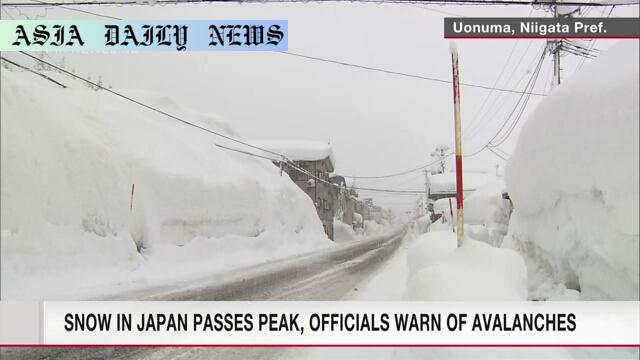Snowfall: As temperatures rise in Japan, officials warn about avalanche risks and snow-related accidents in impacted regions.
- Heavy snowfall in Japan has peaked, but rising temperatures raise avalanche concerns.
- Accumulated snow depths exceed 3 meters in many areas, posing risks.
- Meteorological Agency forecasts warmer weather, urging caution.
- Up to 15 cm of snow expected in certain western regions by Tuesday afternoon.

Heavy Snowfall Peaks in Japan
Japan’s Meteorological Agency has reported that the heavy snowfall across the country has reached its peak. However, rising temperatures are triggering serious avalanche warnings and concerns about accidents caused by melting snow. Across snow-hit areas, accumulated snow measures as high as 3.87 meters in Uonuma City, Niigata Prefecture, and 3.27 meters in Ohkura Village, Yamagata Prefecture.
Warming Temperatures Bring Risks
Forecasts indicate that temperatures will rise to or surpass seasonal averages by Tuesday. Regions such as Tokyo and Fukuoka may experience temperatures around 12 degrees Celsius, while cities like Osaka and Sendai are expected to see 10 degrees Celsius. This dramatic rise in temperatures will likely accelerate snowmelt, which can lead to the collapse of snow-laden structures and increase the risk of avalanches.
Localized Snow Accumulations
Despite the warm forecast, certain regions continue to experience localized snowfall. Up to 15 centimeters of additional snow might fall in the Kinki region of western Japan by Tuesday afternoon. This could add extra weight to accumulated snow on roofs and roads, emphasizing the importance of staying vigilant for falling snow hazards.
Precautionary Measures Advised
The agency strongly advises residents in snow-hit areas to exercise caution. Homeowners are urged to clear accumulated snow from roofs to prevent dangerous collapses. Emergency services are also on high alert to address weather-related accidents promptly.
Broader Implications of Snowfall and Melt
The implications of such heavy snowfall and subsequent warming extend beyond immediate risks. Transportation disruptions, delayed deliveries, and school closures are among the challenges faced by residents. Moreover, there are significant economic implications due to snow removal and damage repair costs. Local government agencies and community organizations are coordinating efforts to manage these challenges effectively.
Preparing for Mid-April Conditions
As the week progresses, temperatures are expected to align with averages for early to mid-April. This could represent a temporary relief for snow-bound areas but might also lead to increased meltwater, causing localized flooding. The transition from heavy winter snow to early spring conditions represents a delicate period that requires increased vigilance from both residents and authorities.
Conclusion
The combination of heavy snowfall, warming temperatures, and melting snow poses a significant challenge for snow-hit regions across Japan. While the worst of the snowfall appears to be over, the risks from avalanches and snow-related accidents remain acute. Vigilance and proactive safety measures will be critical during this transitional period.



Commentary
The Challenges of Snow and Temperature Fluctuations
The recent heavy snowfall in Japan has served as both a spectacle and a challenge for many regions. While picturesque landscapes created by deep snow may charm the eye, the reality for those living in affected areas is far less idyllic. Snow accumulation exceeding three meters in some locations brings with it a myriad of safety concerns, from structural instability to the ever-present danger of avalanches.
A Climate of Extremes
The warming trends forecasted to follow this extreme snowfall only add to the complications. Rapid snowmelt increases the potential for localized flooding, while heavy, wet snow sliding from rooftops poses dangers for pedestrians. The seasonal transition from winter to spring in Japan has always been a complex affair, and this year’s events highlight the growing impact of climate variability.
Community and Government Response
On a positive note, the response from local authorities and community organizations has been commendable. Advanced warnings, cautionary guidelines, and emergency preparedness are helping to mitigate risks. However, there is always room for improvement to strengthen adaptation strategies and infrastructure resilience in future events.
A Time for Vigilance and Cooperation
For residents of Japan’s snow-hit regions, the coming week will require careful attention to the weather and adherence to safety advisories. It is a time for communities to band together, support one another, and prioritize safety above all. With proactive steps, these regions can emerge from the challenges posed by this unusual bout of winter weather more prepared for future events.